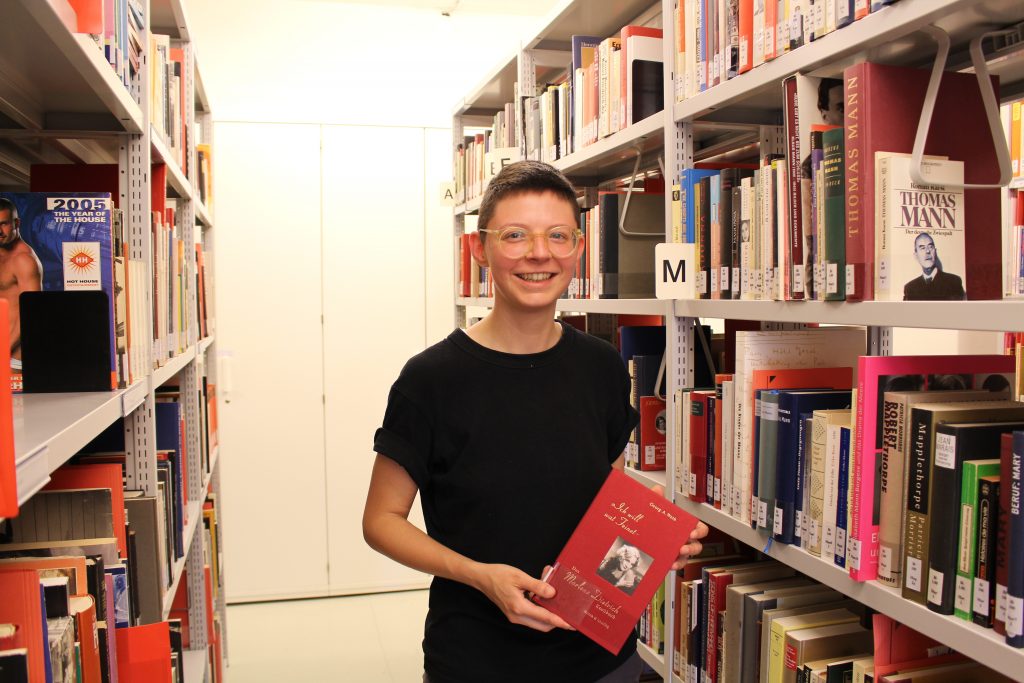The SMU in July
Heard the latest? The Schwules Museum wants to move to Berlin-Kreuzberg! Well, at least according to a slew of recent headlines in the Berlin press. Immediately, regular guests and friends bombarded us with questions: How soon will the location in Berlin-Tiergarten be locked-up? And why didn’t we tell?
Here are the facts: We’ve thoroughly enjoyed being in Lützowstraße, but we’re running out of space – our expanding collection has outgrown the available storage space on the lower ground floor; our employees on the first floor really deserve more space, too. So it’s true that we’re thinking about our future. A Senate-financed feasibility study is currently investigating various alternative locations and spaces in Berlin, some of which would indeed be in our old home district Kreuzberg, from where we moved seven years ago (we required more space even then), or maybe an option for a new build. The ruling Kreuzberg Green Party would very much like us back, so they officially announced their support in the last local council meeting; hence the headlines.
However: The results of the feasibility study have not yet been officially published yet. Of course we can well imagine moving back to Kreuzberg – after all, we did spend lots of wonderful years there, and the area is within easy reach from every part of Berlin. However, nothing has been fixed yet, and we’ll definitely not move before the next three years have elapsed. So, it’s still castles in the air, rather than a fixed abode.
We promise: We will let you know in time, once you should memorise a new adress. Until then, you know where to find us. See you soon at Lützowstraße!
Yours,
the SMU-Team

Current exhibitions
Discover queer subculture through the eyes of Amos Badertscher and Nihad Nino Pušija: “The Souls Around Us” and “Queens”, presenting non-heteronormative realities in Baltimore and Berlin, are still running until the 27 July. If you’re still in need of a reason to go, find them here in a lengthy discussion with Nino in ”Art in Berlin” or here in a great article by the New York ”Artforum” on the Badertscher-show.
Running beyond July, our splendid archive exhibition “100 Objects: An Archive of Feelings” is still on, as is our perennial favourite “Love at First Fight!”, which completes its one-year run by 19 July. Since we still can’t throw big parties, take a look within normal opening-hours and say Happy Birthday.
Live from the Schwules Museum

We hope to host live-events with guests at the Schwules Museum as of August. Before, please enjoy a unique Livestream on 9 July at 7pm, where Heinz-Jürgen Voß and Christopher Sweetapple present their new book “Intersektionalität: Von der Antidiskriminierung zur befreiten Gesellschaft?” (”Intersectionality: From anti-Discrimination to a liberated Society?”) live via our facebook-channel, followed by a discussion. (The event will be in German.)
The call for Intersectionality began to be raised in Germany in the early 1990s by leftist activists, Jews, People of Color, and/or people with disabilities, who did not see their situation of being discriminated on a multiude of levels accounted for in the targeted activism of, for instance, the women’s and the gay movements. Today the intersectional approach, which adresses prevalent racism, is particularly widely applied in the queer-feminist spectrum of color. But it also faces impetuous objection not only by the right, but also from the left. The accusation being, that “identity politics” are pursued at the expense of a commitment to a fundamentally different, better society overall.
The presentation of the book, which Sweetapple and Voß wrote collaboratively with Salih Alexander Wolter, seeks to give a profoundly researched insight into what intersectionality means, both theoretically and practically; and also how it can be applied in a constructive way in leftist politics under today’s conditions.
Volunteer of the Month: Sydney

When Sydney visited the Schwules Museum Berlin as a tourist from Boston in 2015, she knew: ”I want to work here.” It came to be. Today she is studying history at Humboldt University in Berlin and has become a volunteer at SMU. She is found mainly in the library, helping visitors find their way through the book-shelves bearing more than 20,000 pieces of literature. In the interview on our website, she talks about her involvement in the fight against racist police violence alongside her museum work, and she reveals what excites her about porn and why her favourite book from the SMU library is a cookbook.
Object(s) of the Month: A selection of pieces by Petra Gall

The urge for movement shaped her life. Petra Gall was born 1955 in the Saarland-Area, studied history, politics and Slavic Studies in Konstanz and moved to West-Berlin in 1981. The photography she taught herself – so well, that soon taz, Zitty and Courage became aware of her. In the 80s and 90s Petra Gall photographed primarily Berlin’s woman’s and lesbian scene. Later she concentrated on her passion, riding her motor cycle. She produced tour-reports from all around the world.
In 2012 Petra Galls collection was transferred to the Schwules Museum, six years before her death. The three objects of the month, which are displayed at the museum’s café, show the start of her career in 1982: Her first lesbian calendar, which she produced under the pseudonym Petra Panther; a postcard that says ”Die Zukunft ist weiblich” (”the future is female”) from an early series of postcards; and the first issue of the woman-picture-magazine “ATROPiN”, where she was part of the editorial team. Learn more about our objects of the month here.



